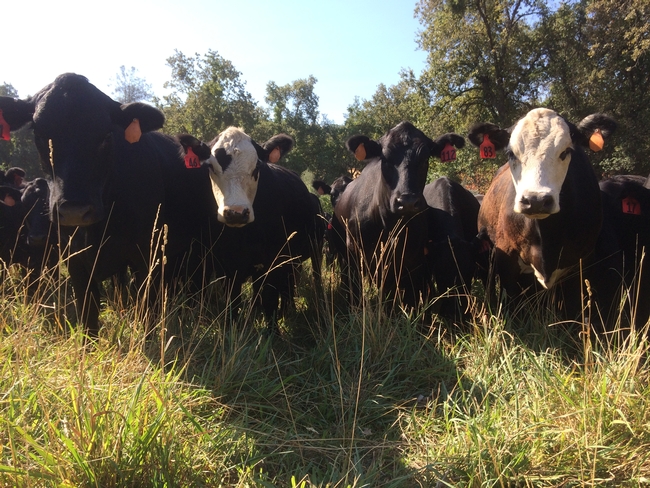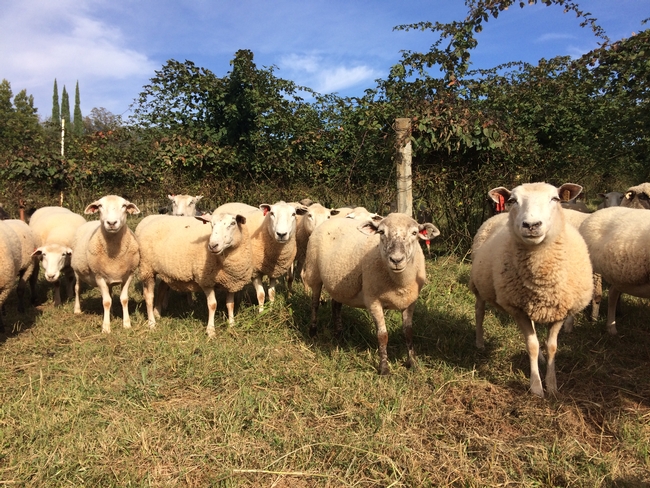

A number of larger ranching operations in the Sacramento Delta have been grazing sheep and cattle together on a large scale with promising results. Typically, a rangeland manager (like me) would suggest that one cow equals five sheep in terms of stocking rate; in other words, for every five sheep a rancher adds to a pasture, he or she would have to remove one cow. The ranchers in the Delta, however, are finding that this ratio doesn't necessarily hold. Ryan Mahoney of Emigh Livestock, for example, reports that he can increase the stocking rate on his pastures by grazing sheep and cattle - without over-utilizing the pastures.
But what about animal performance? Obviously, the point of any commercial grazing operation is to put pounds on livestock or to produce offspring. I recently came across a 2001 paper in Proceedings, Western Section, American Society of Animal Science by B.C. Glidewell (of the USDA Agricultural Research Service in Oklahoma), J.C. Mosely (of Montana State University) and J.W. Walker (of the Texas Agricultural Experiment Station). In an experiment conducted at the U.S. Sheep Experiment Station near Dubois, Idaho, the authors compared the diets and average daily gains (ADG) of yearling Columbia ewes and yearling crossbred steers in four treatments:
- Cattle alone
- Sheep alone
- 75% cattle / 25% sheep
- 50% cattle / 50% sheep
Paddock size varied to keep stocking rate constant between treatments. Fecal samples were used to determine the botanical composition of sheep and cattle diets during the 28-day grazing periods.
Keep in mind that the experiment was conducted on a vastly different range type than the annual rangelands and irrigated pastures in our foothill and Sacramento Valley regions. However, the analysis of dietary preferences suggests more dietary overlap that I would have expected. The diets of both were grass-dominated (see Table 1).
| Livestock | % Grass | % Forbs | % Shrubs |
| Cattle | 80% | 19% | 1% |
| Sheep | 76% | 22% | 2% |
Table 1: Dietary Preferences
When sheep and cattle grazed together, dietary overlap averaged 86%. These findings were consistent with other research conducted on similar forage types in eastern Oregon (Vavra and Sneva 1978), which found dietary overlap of 78-86%. They differed from results in western North Dakota (Kirby et al. 1988), which found 30-35% overlap. The nutritive quality of sheep and cattle diets (as measured by the percent of crude protein (CP) and neutral detergent fiber(NDF)) did vary by treatment. Cattle diets were less fibrous when they grazed with sheep (that is, they were lower in %NDF), likely because cattle ate less grass due to competition with the sheep.
Steer performance (measured in ADG) did not vary significantly among treatments, but did trend higher as the proportion of sheep increased. Similarly, the performance of the yearling ewes in the trial trended higher when sheep grazed with cattle.
The authors also compared total gain per hectare (roughly 2.5 acres). As you might expect, total gain per hectare was related to growing-season precipitation in eastern Idaho. Interestingly, total gain by hectare also seemed to be related to the combination of sheep and cattle. In a wet year, multi-species grazing produced more pounds of livestock per hectare than cattle grazing alone. In a dry year, multi-species grazing produced as much gain per hectare as cattle grazing alone. The authors suggest that over the long term, at least in eastern Idaho, gain per unit of rangeland should increase by grazing cattle and sheep together.
Obviously, multi-species grazing won't fit every operation. Sheep and cattle often require different working facilities, fences, and management skills. However, as ranchers in the Delta are finding anecdotally, grazing cattle and sheep together may actually increase production from a given pasture. We should consider doing a similar study on annual rangelands and irrigated pasture!
Here's the complete reference to the paper:
Glidewell, B.C., J.C. Mosley, and J.W. Walker. 2001. Sheep and cattle response when grazed together on sagebrush-grass rangeland. Proceedings, Western Section, American Society of Animal Science. 52: 156-159.